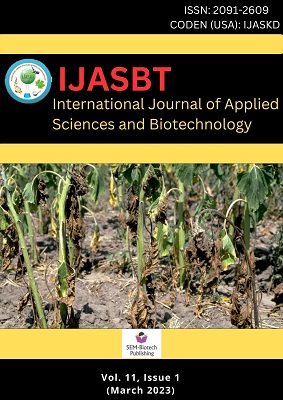Controlling Tobacco Diseases: An Overview of Black Shank and Fusarium Wilt
DOI:
https://doi.org/10.3126/ijasbt.v11i1.52440Keywords:
Tobacco Plant disease, Blackshank, Fusarium WiltAbstract
Black shank, caused by Phytophthora nicotianae, and Fusarium wilt, caused by the Fusarium oxysporium f. sp. nicotianae, are major diseases affecting tobacco crops globally. Phytophthora nicotianae is primarily found in tropical and subtropical regions and infects tobacco plants by producing zoospores that swim to root tissue and form cysts. Symptoms of black shank include root and crown rot, wilting, leaf chlorosis, stem lesions, and pith necrosis. Management strategies for black shank include cultural practices, chemical treatments, and host resistance. Chemical fungicides, such as metalaxyl or mefenoxam, oxathiapiprolin, and fluopicolide, can be used but there is a risk of fungicide resistance. Fusarium wilt is characterized by yellowing, drying, and death of leaves, leading to the death of the entire plant. Control measures for Fusarium wilt include plant resistance, cleanliness, crop rotation, nutrition, nematode management, and fumigation or biofumigation. The most successful control of Fusarium wilt has been through the use of resistant tobacco cultivars. The impact of rotation crops and resistant plants on the pathogen populations in the soil must be evaluated and soil pH and calcium levels may also impact the disease. The presence of the fungus in a field can last for several years without a vulnerable host.
Int. J. Appl. Sci. Biotechnol. Vol 11(1): 1-7.
Downloads
Downloads
Published
How to Cite
Issue
Section
License
Copyright (c) 2023 International Journal of Applied Sciences and Biotechnology

This work is licensed under a Creative Commons Attribution-NonCommercial 4.0 International License.




